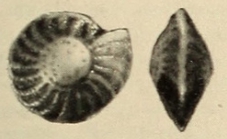Foraminifera name details
Elphidiella multiscissurata Smout, 1955 †
911950 (urn:lsid:marinespecies.org:taxname:911950)
unaccepted (Type species of Palaeoelphidium)
Species
marine, brackish, fresh, terrestrial
fossil only
Smout, A. H. (1955). Reclassification of the Rotaliidea (Foraminifera) and two new Cretaceous forms resembling Elphidium. <em>Journal of the Washington Academy of Sciences.</em> Vol. 45, No. 7 (July 1955), pp. 201-210., available online at https://www.biodiversitylibrary.org/part/70624#/summary
page(s): p. 208 fig. 6-9 [details]
page(s): p. 208 fig. 6-9 [details]
Hayward, B.W.; Le Coze, F.; Vachard, D.; Gross, O. (2021). World Foraminifera Database. Elphidiella multiscissurata Smout, 1955 †. Accessed at: http://marinespecies.org/foraminifera/aphia.php?p=taxdetails&id=911950 on 2024-04-16
Date
action
by
original description
Smout, A. H. (1955). Reclassification of the Rotaliidea (Foraminifera) and two new Cretaceous forms resembling Elphidium. <em>Journal of the Washington Academy of Sciences.</em> Vol. 45, No. 7 (July 1955), pp. 201-210., available online at https://www.biodiversitylibrary.org/part/70624#/summary
page(s): p. 208 fig. 6-9 [details]
basis of record Ellis, B. F.; Messina, A. (1940-2015). Catalogue of Foraminifera. <em>Micropaleontology Press, American Museum of Natural History, New York.</em> [details]
page(s): p. 208 fig. 6-9 [details]
basis of record Ellis, B. F.; Messina, A. (1940-2015). Catalogue of Foraminifera. <em>Micropaleontology Press, American Museum of Natural History, New York.</em> [details]
From editor or global species database
Original description The test is composed of hyaline, radially fibrous, perforate calcite and is laminated in the usual manner of the Rotaliidea. It is small and lenticular to biconical with a subacute, feebly carinate margin. The spire is simple and planispiral and the chambers are involute and equitant. The umbonal region on each side is about one third of the diameter of the test and occupied by a boss that is usually slightly raised. The chambers of the last half whorl are separated from the boss by a groove, which is continued as a spiral of about one and a half turns of pores. Only the last whorl of chambers is visible externally. The sutures are radial and slightly curved, limbate mostly but incised for the last few chambers. Each suture has a row of about 10 pores on each side of the test. They incline alternately forward and backward over the chambers, with tributary grooves that are inconspicuous over the latest chambers, but become more obvious on the older, thickened chamber walls. The alternate inclination of the sutural canals makes the row of pores appear double. There are no retral processes, nor any rudiments of them, but this can only be seen clearly on the last two or three chambers, which are often not preserved. The aperture is cribrate, being a row of about 10 pores in the interiomarginal position. No intercameral foramina have been observed with certainty. The proloculum is small andspherical. Dimorphism has not been observed. [details]
